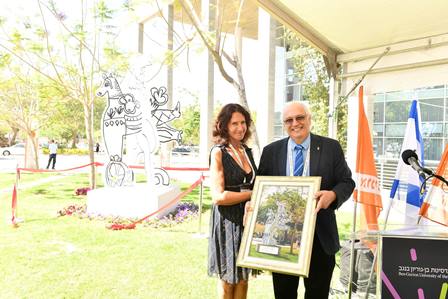In a signal honor, The Acrobats sculpture,
one of the late famed artist Théo Tobiasse’s final creations, was unveiled on
Ben-Gurion University of the Negev’s Marcus Family Campus last week during the
47th annual Board of Governors Meeting. His daughter, Catherine
Faust-Tobiasse, was honored for her decision to donate her father’s sculpture.
Prof. Steve Rosen, VP for External Affairs,
explained why its placement on campus and BGU itself resonated strongly with
the piece.
“In the past this lawn has been a blank
space, neutral, artists call it negative space (although not in a negative
sense), but since the sculpture was installed here, it has become active,
positive; the statue has become a conversation piece for students, staff and
passersby, stimulating, initiating, lively. We see people stopping to examine
it, expressing their curiosity, and the feedback we have received has been
enthusiastic, noting its modern style and fresh spirit. And this is why,
Catherine, we are so glad that together with you, we chose this vibrant spot on
campus as the place for your generous gift,” he told Catherine.
“Théo Tobiasse also had a great passion for
technology and innovation, playing with forms, possibilities and new ideas in a
way of thinking that had no limits: everything was possible, as illustrated by this
monumental sculpture, which is a celebration of life in its full inventiveness.
And that is why we, President Prof. Rivka Carmi and myself, feel that the piece
so perfectly complements the vibrant and dynamic atmosphere prevailing at BGU,
making a great tribute to the legacy and spirit of your father Théo Tobiasse,”
he added.

Catherine Faust-Tobiasse talked about her
father’s beliefs and his influences.
“First of all, I am very honored and
excited to see this work of my father's now permanently placed here, to witness
forever all of the magnificent technological advances and discoveries happening
here. My father would also be very proud, as he was always so interested in
Israel and committed to it. Born in Israel in 1927 after his parents fled from
Lithuania following the pogroms, his father was a profound Zionist, striving to
make Theodore Herzl's vision of the creation of the State of Israel a reality,”
she told the audience.
“I chose to donate this sculpture to the University
because I was touched by the innovative and pioneering spirit prevailing in
this place of knowledge, study and development of extraordinary technology, a
spirit that dominates here leading to authenticity and excellence. From his
studio in Saint-Paul de Vence, my father never ceased to keep himself up to
date with all the progress Israel brought to the world.
“This work, The Acrobats,” she
explained, “is one of his last monumental sculptural projects. It is an
original edition made of cut and painted steel, three meters high, created in
1997 after being simulated as a model and as an acrylic illustration on carton.”
“My father had always strongly been
inspired by the world of the circus, fairgrounds and carnivals, especially the
carnival of Nice, for which he designed the albums and posters for many years.
The theme of the woman was also always present in his work throughout his whole
period of creation, from 1958 to 2008: exuberant, demonstrating all desires,
majestic and eccentric. His work also combined themes of the Bible and exile,
and his childhood memories from Lithuania with the snow-covered sleds and
bulging samovars and teapots, symbolizing the warmth of the family.
“It is a celebration of joy and spirit, a
positive attitude toward life that always guided my father. This strong desire
to taste the joy of life was even more intense than the profound pain he had
known, which would never heal: the pain of terror and tears, originating in the
terrible Nazi period, from which he was miraculously saved. That darkness would
later on lead him toward light and the tremendous sky of la Côte d’Azur, but
also to the joy of painting and creation and to the light of Jerusalem, which,
as he used to say, was always inside him, as he was travelling around the
world,” she reflected.
About Théo Tobiasse
Théo Tobiasse was born in Jaffa in 1927 to
a family of Lithuanian origin. They relocated to Paris in 1931; there he
survived the Holocaust in hiding, comforted only by his books and drawings. He
moved to Nice, but finally settled in Saint-Paul de Vence, where he lived and
worked until his death on November 3, 2012. He was influenced by the works of
Rembrandt, Dubuffet, Claver, and Picasso, who was also a friend.
Experimenting with a variety of mediums,
Tobiasse used painting, sculpture, etching, pastel, drawing, pottery, and
stained glass to express his emotions. Celebrated throughout the world,
his works have been exhibited in solo and group exhibitions worldwide and are
held by leading international museums.
